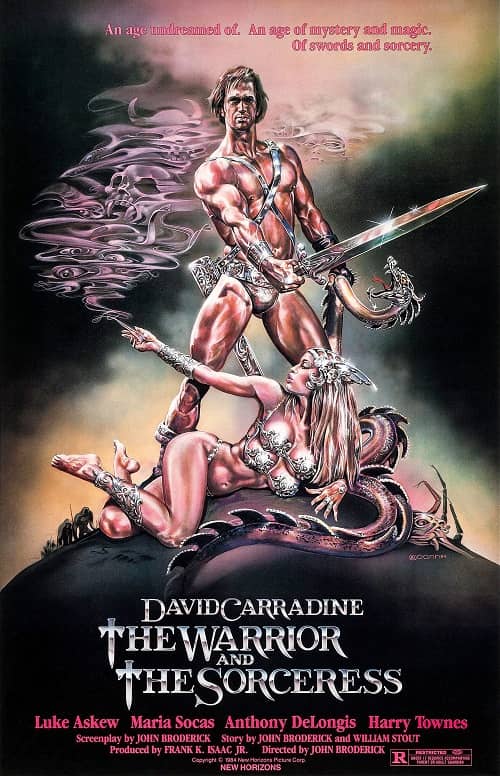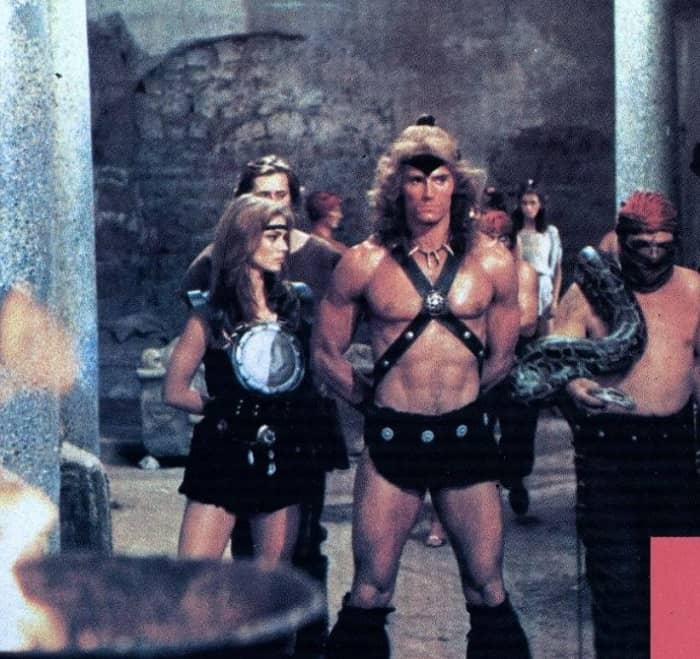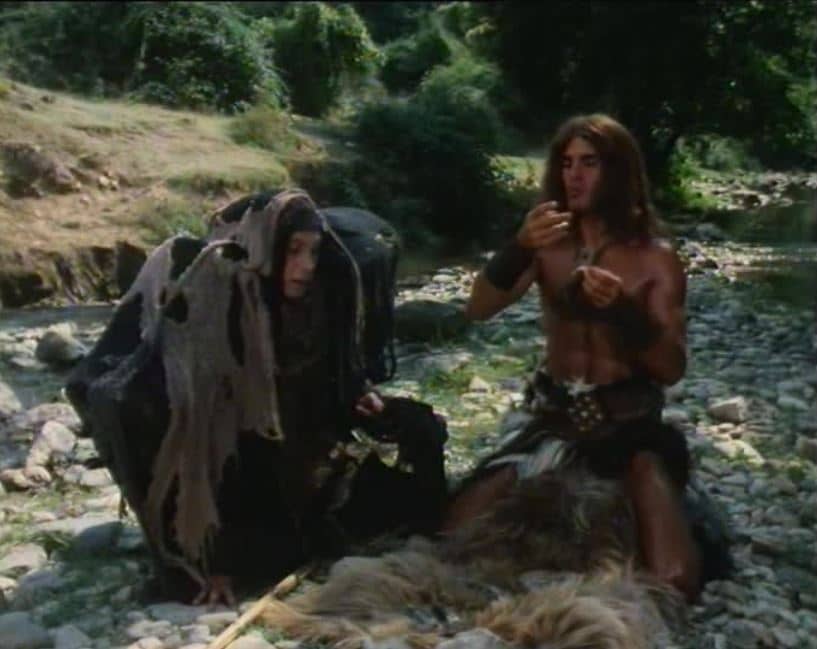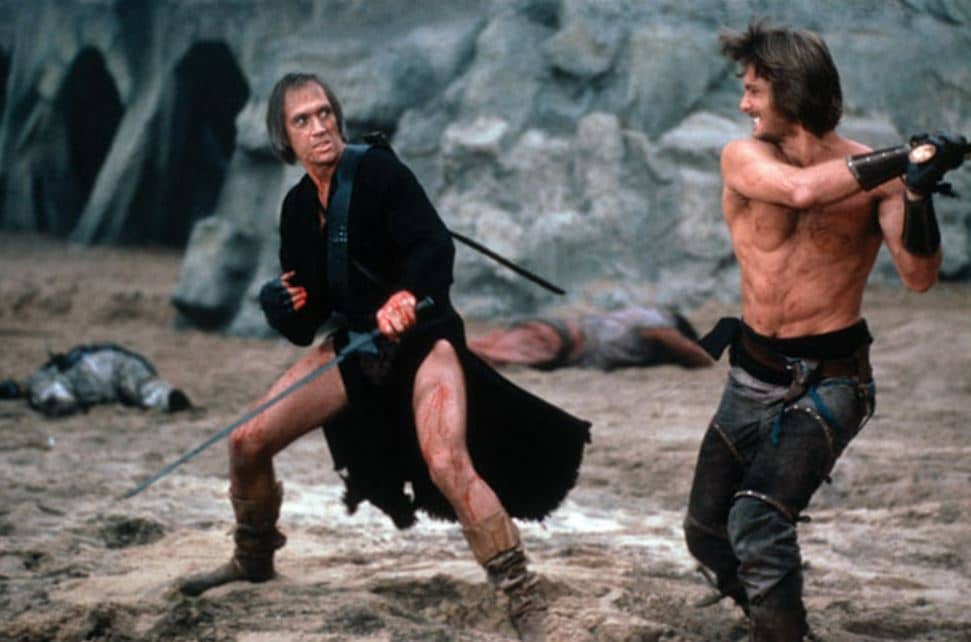Ellsworth’s Cinema of Swords: The Barbarian Boom, Part 4
The Warrior and the Sorceress (Argentina/USA, 1984)
Barbarians don’t get no respect. The fantasy films released in the wake of the unexpected worldwide success of Star Wars (1977) were all over the map, varying widely in approach and quality, but the barbarian lookalikes that followed the first Conan movie (1982) stuck to a formula, in quality plunging straight to the bottom of the barrel and mostly staying there as the barrel bumped along the cheapie exploitation circuit for the next five years or so. It’s as if filmmakers saw the sword-and-sorcery genre as suitable only for low-prestige flicks aimed at an unsophisticated market, a sad situation that wouldn’t really turn around until The Fellowship of the Ring (2001).
Ator 2: The Blade Master
Rating: *
Origin: Italy, 1984
Director: Joe D’Amato
Source: Quadrifoglio DVD
This is a legendarily bad fantasy adventure. Now, plenty of low-budget fantasy adventures are bad, but they’re usually bad in predictable ways. The Blade Master’s badness is largely unpredictable and unexpected, a whole film of WTF moments.
That’s not to say it isn’t also bad in the ways one would expect: a script that’s dead on arrival, terrible lip-synching, third-rate acting, and somnambulistic combat — the blade choreography isn’t bad, but it looks like they didn’t practice very much, so they go through the moves slowly to make sure nobody gets hurt. Safety first, I guess.
“Knowledge is nothing against fate. My discovery is everything… and nothing.”
The movie starts with a long scene in a cave full of brutal Neolithic folk, cave people who have virtually nothing to do with anything except that Quest for Fire (1981) had been popular recently. Grunt! Switcheroo, and suddenly we’re in a Renaissance castle where, in a cavern laboratory (every interior in this film is staged in a cave) the wise sage Akronos (Charles Borromel) is showing his nubile and weirdly fur-clad daughter Mila (Lisa Foster) his latest discovery, a glowing box he calls the Geometric Nucleus, literally the worst MacGuffin name ever.
It mustn’t fall into the hands of the evil Zor (David Brandon), who is approaching with his mounted and weirdly fur-clad warriors. Akronos sends Mila to find the situation’s only savior, the mighty Ator (Miles O’Keeffe). This enrages Zor, who wears a helmet that looks like a big black bird is nesting on his head, and he sends three goons after her.
“The dividing line between goodness and stupidity is very, very fine.”
So, Mila sets out to find Ator… on foot. Apparently, her dad the wise sage has been too busy to teach her about horses. The goons, out of a sense of fair play, I guess, also forego their horses and run after her. In a scuffle, they shoot her with a crossbow, but though wounded she staggers gamely on. Meanwhile Ator, in a cave of course, is practicing his swordplay with his Asian sidekick, whose name is, er, Thong (Chen Wong).
Mila stumbles in, bleeding from the bolt in her shoulder, and Ator and Thong put her on a surgical table, because Ator is not just a musclebound shirtless swordsman in a fur speedo, he’s also a learned scholar! Thong puts big green leaves on Mila’s face while Ator pulls out the bolt. Soon, she’s all better — but Ator decides Mila must “prove herself” before he’ll believe her story, so he locks her in a convenient iron-barred cell. Mila shows her stuff by grinding some rocks together and combining their dust to make black powder, and then blowing the door off her cell. Didn’t see that coming, did you?
The three of them head back to rescue Akronos… on foot. The journey that formerly took Mila about twenty minutes now takes several days, as Ator gets ambushed a bunch and goes on frequent side quests. The ambushers include three costume-party samurai, a mystic cave full of invisible assailants (always the easiest enemies to costume), and cannibal cavemen, while the side quests include returning to Ator’s birth village, where he fails to prevent a clumsy massacre, and then gets captured by serpent cultists. In yet another cave, Mila gets thrown into a snake pit, and to save her Ator must fight a giant rubber snake puppet so flaccid he has to wrap it around himself to make it look dangerous.
“It would be less repugnant to be strangled by a thousand serpents than to have to endure your smile.”
They finally get back to Akronos’ castle, where Ator splits the party again (he does that a lot), telling Mila and Thong to sneak in the back way while he attacks from the front. He vanishes into the underbrush and then reappears over the hilltop — on a hang glider that he apparently built from sticks, his shoelaces, and a bolt of fabric he had in his quiver. (Didn’t see that coming, did you?) He spends about five minutes on a scenic glide over an entirely different castle, dropping black powder bombs on Zor’s goons, and then drops down for the climactic battle.
“My life is too dangerous to share.”
Victorious, mighty Ator rides off to oppose evil wherever he finds it. And, hey, he found a horse after all!
Thor the Conqueror (or The Mighty Thor)
Rating: *
Origin: Italy, 1983
Director: Tonino Ricci
Source: YouTube streaming video
You can argue about which movie of the Eighties barbarian boom was the best, but when it comes to which is the worst, there’s no debate: it’s the Italian film Thor the Conqueror.
If you’d just seen Conan the Barbarian and had 500 bucks, a camera, and some smoke bombs for atmosphere, this is the movie you’d make. It’s so utterly bad that its badness would be entertaining in itself if the film wasn’t also appallingly misogynistic. It starts as a barbarian warrior named, er, Kunt (Angelo Ragusa) marches resolutely across the wilds followed by his heavily pregnant wife and an obnoxious shape-changing wizard called Etna (Luigi Mezzanotte).
Arriving at some standing stones dedicated to the god Teisha, the wife gives birth to the infant Thor just as they are attacked by another warrior, Gnut (Raf Baldassarre), and his tribe of white-faced barbarian mimes, who want Kunt’s magic sword. Kunt and his wife are slain, but the magic sword turns into a snake and escapes, as does Etna with the newborn baby. The obnoxious wizard raises Thor (Bruno Minitti) to shirtless adulthood and then sends him off to, you guessed it, avenge his parents’ murder.
Everything about this is terrible, predictable, and terribly predictable. Thor talk like caveman, except when he speaks in full sentences before he suddenly talk like caveman again. Because Etna says so, Thor must fight three “Warrior Virgins” wearing ridiculous straw helmets, killing two of them but sparing the third so he can rape her, saying, “You will bear the fruit called children!”
Naturally, Ina (Malisa Longo) adores her rapist and becomes his loyal helpmeet. Thor comes to a stupid village and gets into a stupid fight and conquers it, eating their stupid roast squirrels and then planting some magic seeds he found earlier that are immediately forgotten. Then Gnut and the barbarian mimes find him, capture both Ina and Thor, and blind Thor by coating his eyes with cheap black eyeliner.
They release him back into the wilds but, Etna magically sends Thor a non-venomous python and (surprise!) Thor milks its non-venomous fangs onto some moss, uses the moss to rub away the cheap eyeliner, and his vision is restored! He blesses the god Teisha, then finds his dad’s magic sword and you know where it goes from there.
The sets consist of some huts made of branches, a few carved stones, and a bunch of skulls on sticks. There are unexplained cheap SFX ghosts, for some reason. The costumes are burlap sacks and fur, because barbarians, and even the weapons have fur on them because I guess that makes them barbaric. Everyone, Thor included, says, “Rahh!” a lot while waving their weapons. Drink responsibly, friends—except when watching this movie.
The Warrior and the Sorceress
Rating: ***
Origin: Argentina/USA, 1984
Director: John C. Broderick
Source: Shout! Factory DVD
This is yet another remake of the classic Yojimbo (1961), with as usual no credit to Kurosawa or his screenwriter. This time the story is set on an alien desert planet that like Tatooine has two suns, which post-Star Wars became the standard signifier of an interplanetary setting. The warrior Kain (David Carradine) comes alone out of the desert to the hardscrabble town of Yamata, which has a single well fought over by two gang lords, the militaristic Zeg (Luke Askew) and the bloated and decadent Bal Caz (Guillermo Marín). Yamata’s other main resource is its starving population, whom the gang lords prey upon and occasionally sell to the nonhuman slaver Burgo (Armando Capo).
Kain, a former holy warrior for a dead god now reduced to the condition of mercenary, looks the situation over, decides he doesn’t like either gang lord, and proceeds to play them off against each other, selling his services to one side and then the other. Complications arise when he discovers Zeg is holding Naja (María Socas), a sorceress of his former holy order, as a prisoner because she refuses to forge for him a legendary sacred sword.
Helping Naja escape makes Zeg aware of the game Kain is playing, and the warrior is drugged, captured, and beaten. However, Kain manages to escape nonetheless, to find that Naja has made the sacred sword, but only for him to wield against the gang lords.
Despite the low budget and crappy production values, this film looks pretty good, atmospherically shot with a strong Mad Max vibe to it. Just before filming started, Carradine injured his right hand, so he wears a spiked black glove on it to conceal the cast, performing all his sword work with his left hand in a style taught by the noted fight director Anthony De Longis, who also plays the role of Kief, Zeg’s guard captain. Carradine often looks tired but still manages to muster enough charisma to carry off the role of the laconic Kain, sneering, evading guards, and scaling walls like an Assassin’s Creed hero.
Short though the film is at 81 minutes, once its ending becomes obvious and inevitable it still seems rather too long — one wishes the director would just get on with it. Extra points for the charming puppet monsters, which include Bal Caz’s drooling lizard-headed advisor and a toothy tentacle beast defending Zeg’s dungeon. Fair warning, however: if you’re offended by female nudity, keep well away from this flick. There are so many breasts on display here, one woman even has four of them.
Where can I watch these movies? I’m glad you asked! Many movies and TV shows are available on disk in DVD or Blu-ray formats, but nowadays we live in a new world of streaming services, more every month it seems. However, it can be hard to find what content will stream in your location, since the market is evolving and global services are a patchwork quilt of rights and availability. I recommend JustWatch.com, a search engine that scans streaming services to find the title of your choice. Give it a try. And if you have a better alternative, let us know.
Previous installments in the Cinema of Swords include:
The Barbarian Boom, Part 1
Old School Pirates
Weird Samurai
Euro Dumas Trio
The Barbarian Boom, Part 2
The New Zu Review
The Barbarian Boom, Part 3
An Elegant Weapon for a More Civilized Age
Fantasy Salmagundi
Warmongers
Fables and Fairy Tales
Goofballs in Harem Pants, Part 2
Timey-Wimey Swordy-Boardy
Boy-Toys of Troy
Piracy – Two Wrecks and a Prize Ship
Postwar in the Greenwood
LAWRENCE ELLSWORTH is deep in his current mega-project, editing and translating new, contemporary English editions of all the works in Alexandre Dumas’s Musketeers Cycle, with the fifth volume, Between Two Kings, available now from Pegasus Books in the US and UK. His website is Swashbucklingadventure.net.
Ellsworth’s secret identity is game designer LAWRENCE SCHICK, who’s been designing role-playing games since the 1970s. He now lives in Dublin, Ireland, where he’s writing Dungeons & Dragons scenarios for Larian Studios’ Baldur’s Gate 3.




It’s amazing how many “adaptions” of the Yojimbo plot there have been. Of course, Yojimbo may or may not have been inspired by Dashiell Hammett’s Red Harvest.
Yours are always enjoyable contributions to Black Gate’s site, Lawrence. I think Thor The Conqueror would be worth seeing just to watch the actors trying to keep a straight face whenever they called out Kunt’s name. Yes, my Italian cousins have a lot to answer for in the cinematic department.
David Carradine plays a character named … Kain? Who wanders around a frontier setting, getting involved in local feuds? Almost surprising the producers of Kung Fu did not object.
I remember “The WArrior and the Sorceress” only very vaguely. Most of what I remember was all the nudity and the oddly stylized (although still fun to watch) fighting style that Kain employs.
So, did Carradine just have a phase where he decided every character he would play must be named Caine and be a warrior affiliated with a monastery?
Another Ellsworth’s Cinema of Swords? Huzzah!
While The Sword & the Sorceress is the only one of these films that I have seen, the others SOUND so bad that I begin to fear for the mental & physical health of our reviewer. Mr. Ellsworth, what has been the cost to you for watching these disasters? Have you recovered at all? Have you considered the damage you might suffer if you encountered another Ator movie (or any Miles O’Keefe film) without warning?
Don’t watch these cinematic atrocities just because idiots like me find them amusing. The pangs of guilt assail me already.
Thank you for the post!